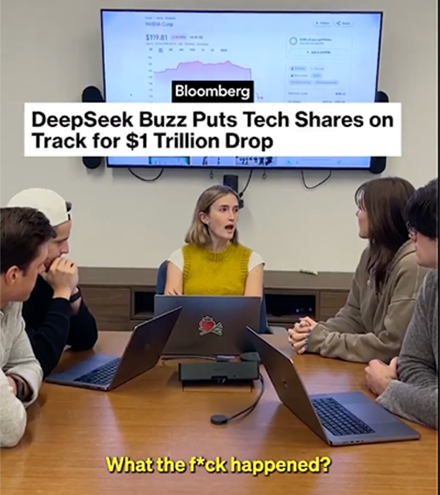 |
|||||||||||
|
|||||||||||
| Deepseek’s Privacy Risks Show Why Companies Need AI Usage Policies |
 |
| While VCs worry about their investments in OpenAI after DeepSeek's rapid rise, users should be more concerned about DeepSeek's privacy policy. The company's data collection practices make Meta look privacy-focused by comparison. (In an ironic twist, OpenAI claims DeepSeek may have improperly used OpenAI's data to train its model through a process called distillation.) But privacy concerns, not training methods, should worry users and business leaders the most. Here's what DeepSeek says about data collection: "When you use our Services, we may collect your text or audio input, prompt, uploaded files, feedback, chat history, or other content that you provide to our model and Services." Under its Automatically Collected Information heading, the company states, "We collect information regarding your use of the Services, such as the features you use and the actions you take." Moreover, the policy says that advertisers and analytics companies share information with DeepSeek about what users do on other sites, apps, and stores. They also match this data to their user's device IDs, email addresses, or phone numbers to help DeepSeek build a profile of individual activities and interests. Over the past few years, we've seen plenty of users accidentally spilling company secrets when using free versions of generative AI tools. DeepSeek offers no protections for its users' data in its privacy policy. Not surprisingly, officials across the globe are warning their citizens about the privacy risks (and the US Navy wisely banned it). The risks are real, and they point to an urgent need for all companies to get a handle on the AI tools their employees are bringing to the office and put some usage policies around it. And yet, a September 2024 survey found that only 44% of companies have such policies in place. "The recent DeepSeek announcement immediately caught our attention and underscores the necessity for all companies to have a robust Responsible Use framework and process in place so that they can immediately evaluate, test, and measure the impact of groundbreaking foundational models on their business, innovation, and customer experiences," Tessa Burg, CTO at digital marketing agency Mod Op said in an email message. DeepSeek won't be the last AI tool to raise privacy concerns. New generative AI services will continue emerging, and employees will inevitably use them. Rather than fighting this reality, business leaders must prepare for it. The solution isn't banning AI tools altogether; it's creating clear usage policies and responsible AI frameworks that protect company data while fostering employee-led innovation. – SS |
 |
| TikTok’s Ad Business Recovers but Skepticism Lingers |
| TikTok’s ad business is regaining momentum after last week’s brief shutdown, with brands cautiously resuming spending. Data from MikMak and Tinuiti indicate ad traffic and sales on TikTok Shop are rebounding, though some major advertisers remain hesitant. Who could blame them after the previous stunt? The platform’s temporary blackout led many brands to reconsider their strategies, creating an opportunity for competitors like Meta, Snap, and Pinterest to lure advertisers and creators away. Ad prices on TikTok have dropped significantly, with CPMs down 29% compared to pre-shutdown levels, presenting a potential bargain for brands. Engagement rates are rising, and TikTok’s rep claims most advertisers have returned, but the uncertainty surrounding its future in the U.S. still looms. While TikTok secured a 75-day extension to negotiate a deal with the government, some critics argue the shutdown was unnecessary, leaving advertisers wary. Meanwhile, TikTok’s rivals wasted no time capitalizing on the disruption. Instagram, Snap, and Pinterest ramped up efforts to attract brands and creators looking for alternatives. Some major advertisers, like those in the auto industry, are still holding off on TikTok ad spend due to lingering uncertainty. Industry insiders suggest that while TikTok is back for now, many brands and creators are keeping their contingency plans in motion, preparing for a potential long-term shift. – AB |
| Retail Media’s Next Phase: In-Store Takeovers, Leadership Moves, and Smarter Strategies |
| The retail media boom isn’t slowing down—it’s just getting smarter. What started as a rush to build retail media networks is shifting toward efficiency, in-store integration, and leadership moves that signal how central this channel has become. Hy-Vee’s Kathryn Mazza just stepped up as CMO while still leading the grocer’s retail media network—proof that retail media isn’t just a revenue side hustle, but a core business strategy. And with brands expected to pump nearly $98 billion into retail media by 2028, it’s clear why they’re giving these networks executive-level attention. The question is no longer whether retailers invest in media but how they align internal teams, tech stacks, and brand expectations for long-term success. One major shift? Retail media is breaking out of digital screens and making a full-fledged in-store play. Retailers like Macy’s and CVS are turning stores into ad platforms, leveraging digital signage, endcaps, in-store radio, and even Wi-Fi logins to engage shoppers at the point of purchase. They’re embedding advertising into the shopping experience without turning it into Times Square. With brand safety concerns growing and third-party data fading, retailers are betting on first-party data-driven ad opportunities—turning in-store media into a high-value, brand-safe, high-impact alternative. The next phase of retail media is about making it work without all the fragmentation. Drew Cashmore, one of the original architects of Walmart Connect, says the shift from “growth at all costs” to operational efficiency is already happening. Retailers are focusing on automation, self-serve ad platforms, and better alignment between brand and business goals. That means less friction, cleaner execution, and—hopefully—fewer walled gardens making media buying a headache. Retail media has reshaped how retailers think about their business, customers, and leadership pipelines. Retailers getting it right think beyond ad placements, making media a natural part of the shopping experience—one that feels intentional and valuable. — LdJ |
 |
||||
|
||||
 |
||||
 |
||||
|
||||
| @{optoutfooterhtml}@ |






